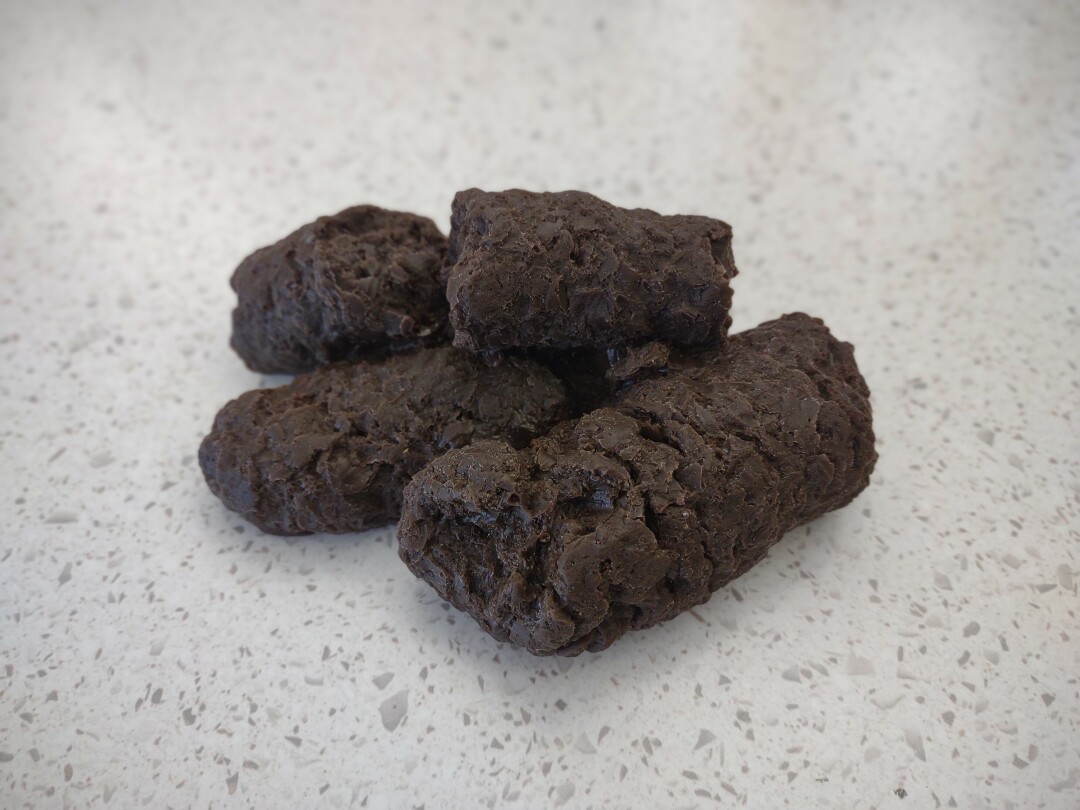Scatology in classroom and on trail

This rubber replica of bear scat helps teach second graders valuable outdoor skills. Photo by Emily Stone.
“Ewww!!!” exclaimed the second graders as I pulled a large rubber replica of bear scat out of the tub. Scat, of course, is the scientific word for animal poop, and we were about to become scatologists.
During my fall MuseumMobile visit to their classroom, we’d talked about the different adaptations that herbivores, omnivores and carnivores need to survive. We examined beaver and deer skulls to see the flat, grinding teeth that herbivores need in order to eat plants.
Next, the jagged, pointy back teeth and long, sharp canines on the wolf skull created quite a stir. Students had no problem imagining how those intimidating teeth help the large carnivore survive.
Then we omnivores ran our tongues over our own canines and molars, and connected our mixed diet with that of a bear.
Last week, during the winter MuseumMobile visit, I wanted to carry that theme a little farther, a little deeper, to its natural end. Hence the replica bear scat.
“Take a look at the Animal Scat Identification Chart in front of you,” I instructed. The chart is divided into three columns, one each for herbivore scat, carnivore scat and omnivore scat.
I had the kids look for shared characteristics among the herbivore scats. The words small and roundish seemed to summarize their ideas.
The carnivore scats were all long and thin, with tapered ends. I explained that those tapers are usually shaped by hairs from the prey animals.
The omnivore scat was somewhere in the middle. The cylinders were much longer than herbivore scat, but had blunt ends instead of the hairy points.
“So who do you think made this scat?” I asked, while holding the handful of rubber bear scat aloft. Several hands shot into the air. Omnivore. That was an easy one.
Next, I pulled out a replica of scraggly fox scat, and a pile of rubber deer scat. No problem. Most kids were confident that they could categorize any scat they might find in the woods. Most kids were delightfully grossed out by the thought. Now it was time for the next step.
“Why would it be helpful to be able to identify scat you find in the woods?” I asked.
A boy, vigorously waving his hand in the air, blurted out “so you can know if there are dangerous animals around!”
I paused for a second, since I’m generally not worried about anything I might encounter in the Northwoods, and I like to remind people how few wildlife-human encounters end up with anyone getting hurt. Then I remembered my Alaskan adventure in 2018.
Hiking by myself on a trail on the edge of an Anchorage neighborhood, large piles of grass-filled brown bear scat put me on high alert. I made sure to keep up a constant chatter of “Hey Bear!” and confirmed that my bear spray was easily accessible. When a moose – and then a brown bear in pursuit of the moose – burst forth from the alder brush I was ready.
Luckily, they were only interested in each other, but I was glad that the scat had given me warning.
After telling the kids the story of my bear encounter, I called for another reason that identifying scat in the woods is helpful.
“So you can know what animals are in the woods, even if they aren’t dangerous,” came the next reply.
I do love that animals leave calling cards along trails and shorelines. It’s often difficult to see the actual animal, but scat is a sure sign that someone has been here.
Recently, on a hike just north of Phoenix, I found a flat rock arrayed with several small scats – each with a twisted tail to indicate that the depositor was a predator.
Looking more closely at the variation in color from damp dark to dusty pale, I could see there were at least four ages of scat in the pile. Clearly this animal was marking territory here on a regular basis.
Two local naturalists I’d encountered on the trail guessed gray fox as the scat’s owner – the same species of gray fox who lives in Wisconsin!
Even though I’d never spot this crepuscular critter, it was neat to know that a familiar neighbor was out there among the saguaro cacti.
As odd as it may seem, being able to identify animal scat significantly enhances my time outdoors. By observing scat, I get to be a detective, a scientist, and a more informed neighbor. Once the kids stop exclaiming about how gross it is, I hope they become all of those things, too.
Author’s Note: Portions of this article were originally published in 2016.
Emily Stone is Naturalist/Education Director at the Cable Natural History Museum. Emily’s award-winning second book, Natural Connections: Dreaming of an Elfin Skimmer, is now available to purchase at cablemuseum.org/books and at your local independent bookstore, too. For more than 50 years, the Cable Natural History Museum has served to connect you to the Northwoods. The Museum is now open with our exciting Growing Up WILD exhibit.
Follow us on Facebook, Instagram, YouTube, and cablemuseum.org to see what we are up to.
